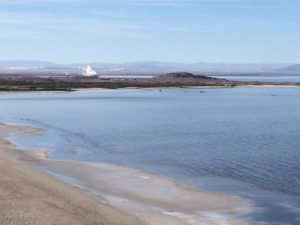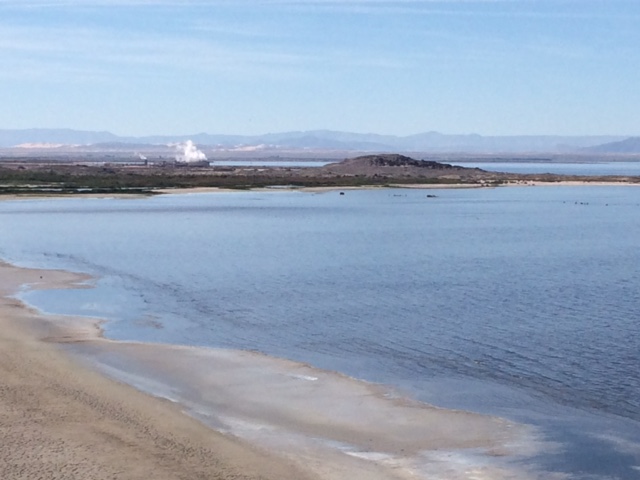
The Salton Sea is pictured from Obsidian Butte in the sea’s southeast section. In the distance is a geothermal plant.
The San Diego County Water Authority is pleased to be participating in two community workshops that have been organized to discuss the latest developments at the Salton Sea. The first will be held March 1 from 5 to 6:30 p.m. at the Imperial Irrigation District (IID) auditorium in El Centro. The second will be March 7 from 5 to 6:30 p.m. at the Coachella City Hall. Speakers at these events will include representatives from the IID, Imperial County, the San Diego County Water Authority and California Natural Resources Agency. After the presentations, there will be a question and answer session with panelists.
The workshops will provide an opportunity to learn more about the Stipulated Order drafted jointly by IID, Imperial County and the Water Authority with support from Natural Resources and environmental organizations and adopted by the California Water Resources Control Board (State Water Board) in November 2017. The Stipulated Order represents a unified effort to strengthen the State’s Salton Sea Management Program (SSMP), a phased approach to restoration, by establishing a set of annual milestones the State must meet over the first ten years of the SSMP. Those first ten years represent Phase One of the restoration program.
Under the Stipulated Order, 30,000 acres of habitat and air quality projects are to be developed by year ten of the SSMP. Additionally, the State is to present a long-term restoration program by 2022. Further, the Stipulated Order provides that the State Water Board will have continuing jurisdiction over the SSMP to ensure the State meets its milestones.
Included in the discussions will be updates on near-term projects that have begun construction or are expected to begin construction this year, including a 500-acre wetlands project at Red Hill Marina on the Sea’s southeast shore, and a project to build a series of ponds also on the southeast shoreline that would support fish life and at full build out would total more than 3,000 acres. The first phase of that project, known as Species Conservation Habitat, would total just over 600 acres. Another restoration project that is already moving forward is a wetlands habitat on Torres Martinez Desert Cahuilla Tribe land along the sea’s northern shore.
Attendees will also hear an update on the environmental mitigation program developed under the Quantification Settlement Agreement (QSA), which was legislation adopted in 2003 as a means of reducing California’s use of the Colorado River to its historic allotment of 4.4 million acre feet annually. As part of QSA legislation, a Joint Powers Authority (JPA) was established made up of IID, Water Authority, the Coachella Valley Water District, and the State Department of Water Resources to oversee a mitigation program for impacts to the Sea specifically tied to the QSA. The legislation established that the three water agencies would be responsible for up to $133 million (in 2003 dollars or what over the life of the QSA will total $288 million) in mitigation costs. The State would be responsible for mitigation costs above that mark, plus have responsibility for carrying out a separate restoration program to address the longer-term environmental issues impacting the Sea.
Since the QSA was signed, the JPA water agencies have met their obligations by providing mitigation water to the Sea from 2003 to 2017, placing air monitoring stations around the Sea, and conducting pilot air quality projects, among other mitigation efforts. Now that mitigation water has ended, the JPA is moving to expand its air quality projects through more permanent on-the-ground measures. While the QSA mitigation efforts and the State’s restoration program—the SSMP—represent two distinct responsibilities, they can and will work hand in hand at the Sea.
The belief is that through these latest developments there is a positive path forward for the Salton Sea, but it will continue to take vigilance and community interaction and involvement. That’s why such workshops as the ones planned for March 1 and 7 are important. We encourage the communities to attend.
